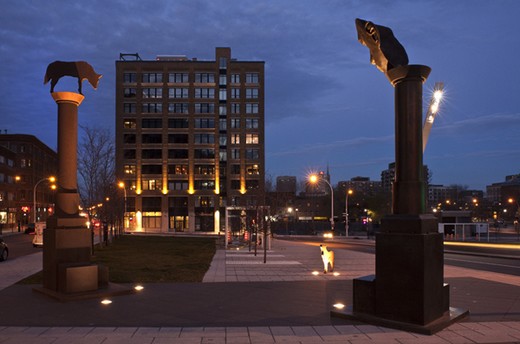| |
|
MAGAZINE D'INFORMATIONJohn McEWEN & Marlene HILTON MOORE, After Babel / A Civic Square (1993).

© michel dubreuil, 2010
L’œuvre est une commande de la ville de Toronto qui en a fait don à Montréal pour le 350e anniversaire de sa fondation.
L’œuvre se place ainsi à la rencontre du langage plastique des deux auteurs. Alors que McEwen vise le rassemblement d’éléments antithétiques autour de thèmes comme la communication, la liberté et le regard, Hilton Moore s’interroge sur les rapports entre le corps et l’espace.
Les deux artistes ont choisi de représenter deux colonnes au sommet desquelles se trouve un masque tendant l’oreille vers le sol et une silhouette animale. Une silhouette canine se trouve également au sol à proximité. L’ensemble sculptural permet d’affranchir le lieu des limites de la communication verbale. Ainsi, entre l’homme et l’animal, la parole est nécessairement rendue obsolète; elle doit laisser place au geste ou à d’autres modes d’expression.
Par ailleurs, pour McEwen, After Babel/A Civic Square « crée une forme de libération entre les langues en insistant sur ces vocabulaires du silence qui permettent de communiquer sans la parole ». Dans cet espace défini comme un lieu régi par un principe d’égalité, l’homme est libéré de la tyrannie du mot.
Fait à noter, cette sculpture-installation en bronze et en acier se trouve dans le quartier des Spectacles. Il s’agit d’un projet d’envergure dont l’objectif est d’ancrer une très grande variété de manifestations culturelles dans un lieu convivial et attrayant.
John McEwen et Marlene Hilton Moore. After Babel/A Civic Square (1993).
Collection Ville de Montréal
Localisation: Place Albert-Duquesne, arrondissement de Ville-Marie.
***
The City of Toronto commissioned this work and presented it to Montréal in celebration of the 350th anniversary of its founding.
The work developed from a meeting point of the art interests of both artists. John McEwen’s concern is to bring antithetical elements together around themes such as communication, freedom, and the role of the animal in imagination, while Marlene Hilton Moore's work examines the relationship of the body, its' gestures and the gaze.
The artists created two columns on the tops of which are a mask with its ear to the ground and a thick steel silhouette of a dog or wolf. Nearby on the ground, there is a thick steel silhouette of a dog. The sculpture grouping frees the space of verbal communication limits. Speech between the man and the animal remains suspended; place must be given to empathy, gesture and other modes of expression.
For McEwen, After Babel/A Civic Square “works to create a clearing between languages. . . . by emphasizing those vocabularies of silence that communicate without using the spoken word.” In this space, defined as a place governed by the principle of equality, man is freed from the tyranny of the word.
The work developed from a meeting point of the art interests of both artists. While McEwen’s concern is to bring antithetical elements together around themes such as communication, freedom and the gaze, Hilton Moore examines the relationship of the body and space.
It should be noted that this bronze and steel sculpture/installation is set up in the Quartier des Spectacles. This is a large-scale project, having the objective of creating an inviting, attractive area for a wide range of cultural events.
John McEwen and Marlene Hilton Moore. After Babel/A Civic Square, 1993.
Collection Ville de Montréal
Location: Place Albert-Duquesne, Ville-Marie Borough
Photos: Michel Dubreuil, 2010. |
|
